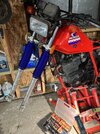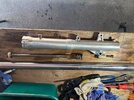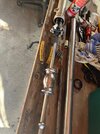When you replace fork seals, it's a common practice to place a condom or use electrical tape on the end of the fork to keep from damaging the seal etc.
For folks that use things like the seal mate, your actually forcing a sharp edge of plastic next to the seal, then scraping it around the dia. of the seal.
How do you not think that this damages the seal?
You also don't know how much oil is in the fork tubes, and how much leaked out etc.
And why risk using a jury rig fix, only to have them blown completely out on your next ride, far away from home.
I say repair it correctly, in the comfort of your garage, with the correct parts and tools and not deal with it twice later.
There are a couple good articles on fork seal replacement on this forum.
I would steer you away from folks on FB and Youtube video's.
If you have any questions feel free to call me on the white courtesy phone, I'm sure I can explain it in detail so you'll be confident in doing the work yourself.

For folks that use things like the seal mate, your actually forcing a sharp edge of plastic next to the seal, then scraping it around the dia. of the seal.
How do you not think that this damages the seal?
You also don't know how much oil is in the fork tubes, and how much leaked out etc.
And why risk using a jury rig fix, only to have them blown completely out on your next ride, far away from home.
I say repair it correctly, in the comfort of your garage, with the correct parts and tools and not deal with it twice later.
There are a couple good articles on fork seal replacement on this forum.
I would steer you away from folks on FB and Youtube video's.
If you have any questions feel free to call me on the white courtesy phone, I'm sure I can explain it in detail so you'll be confident in doing the work yourself.




